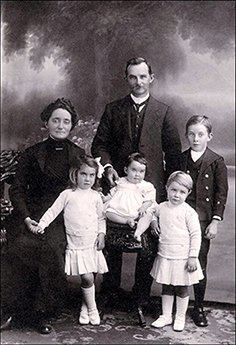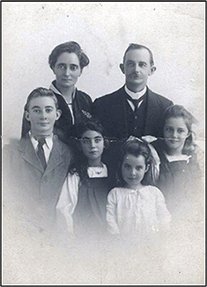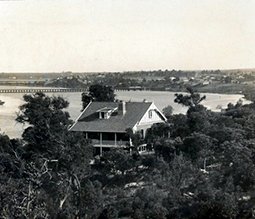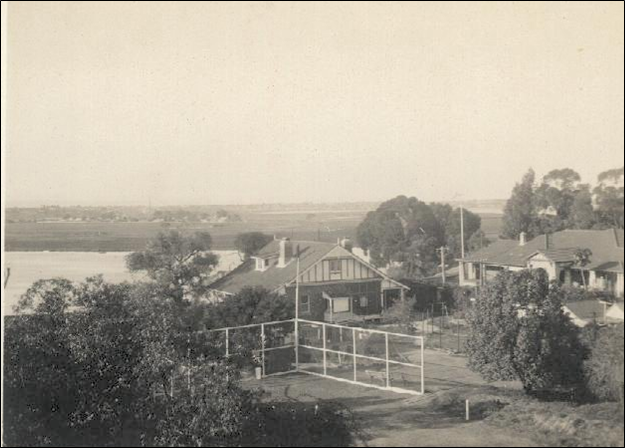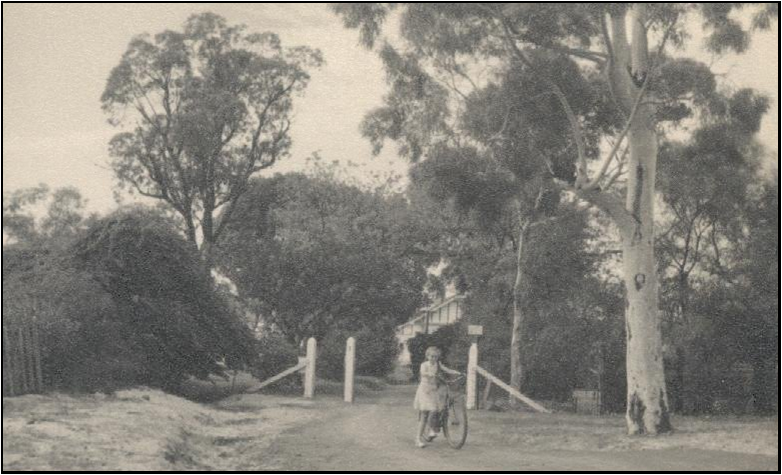Arthur Allan Lightfoot was born on 16 October 1874 in Melbourne, Victoria, and his parents were Thomas Hancock Lightfoot (1839-1904) and Emily Lightfoot nee Jones (1845-1918). Arthur began working for the railways in WA on 31 August 1896 becoming an electrical fitter. As a single man, he lived at 16 Dangan St, Perth, and then in Mueller Road, Subiaco, with his mother Emily.
He married Lilian ‘Lilly’ May Clark (1879-1970) who was the youngest daughter of James Clark (1828-1889) and Anna Baird Clark (1831-1913) of Noarlunga, South Australia, and the sister of Edith Agnes Clark who had married Peter Albany Bell on 11 March 1896 in Noarlunga, South Australia. Arthur and Lilian were married on April 27 1904 (photo below left) at the residence of Mr Peter Albany Bell, ‘Noarlunga’, Highgate Hill, Perth. After their wedding, Arthur and Lilian continued to live in Subiaco before moving to 126 Addis Street, Picadilly (a suburb of Kalgoorlie), with their children. This was presumably to work in the Kalgoorlie confectionary tearoom business of brother-in-law Peter Albany Bell.
Arthur and Lilian Lightfoot had four surviving children (photo above middle and right), namely Leonard Charles (1905-1984), Enid Emily (1909-2005), Marian Edith (1911-1993) and Rosalie Baird (1913-1993). They also had a son, Allan James, in 1907 but he died aged one year and eight months in January 1909. One can see that several of the children’s names were after their parents and grandparents.
In 1911, Albany Bell formed the company, Albany Bell Pty Ltd, Manufacturing Confectioners, with partners Albert Johnson and Arthur Allan Lightfoot. The employees were allowed a fortnight’s annual holiday with fares covering 240 kilometres distance from Perth. Albany’s brother Jim ran the goldfields premises, where the employees were granted a fortnight’s paid holiday, paid rail travel to a seaside resort and full board at that resort for the fortnight.
‘Ellesmere Estate’ brochure
Arthur bought a block of land, Lot No 22 of the Swan Location Y, on 4 November 1911 for £600 from Mrs Isabella Hynes, and the land ran from Thirlmere Road down to the Swan River. The Lightfoots lived on Guildford Road whilst the house was being built. The house in Thirlmere Road, Mt Lawley, was completed in 1914 and known as ‘Onkaparinga’ which comes from the Kaurna word ‘Ngangkiparingka’, which means ‘women only places along the river’. ‘Ngangki’ means ‘women’, ‘Pari’ means ‘river’, and ‘ngka’ means ‘location’. Interestingly, Onkaparinga is also a region in South Australia that includes the suburb of Noarlunga. The house (pictured below left) had 22 rooms, three storeys and flats for a maid and a chauffeur-footman. It had the ‘Castle’ housing the confectionary/tearoom business of Peter Albany Bell on one side and a large Federation bungalow owned by Mr Arthur Daley on the other side. It had a tennis court, impressive gardens running down to the river with magnificent views, and a gate in Thirlmere Road. Further along Thirlmere Road, beyond Mr Daley’s property, was The Lodge (part of the Killowen Estate) and then Killowen House with its entrance in Ellesmere Road owned by Robert Thompson Robinson (see the Mt Lawley Society newsletter From the Verandah, Vol 46-1-2023).
Onkaparinga (looking towards Causeway c1910
1 Thirlmere Road front gate about 1950, Janet Oakes, Enid’s daughter with bike
Tennis party at Lightfoot’s in 1940
Enid with John Oakes Model T Ford
Arthur progressed in the confectionary and tearoom business owned by his brother-in-law, becoming a senior manager at the factory in Guildford Road. Consistent with Peter Albany Bell’s philanthropic beliefs, by 1928 Bell and Arthur Lightfoot had established a subsidiary company in the factory called ABC Confectionery in which committed employees were made shareholders.
In early 1928, Arthur Lightfoot purchased a farm in Carnamah, WA, from Mrs Norah Woodhouse. The farm was a 773-acre lot situated on the south side of what is now Waters Road. His eldest son Leonard Charles farmed the land in Carnamah between 1928 and 1933 in partnership with his father Arthur as Lightfoot & Son. For most of 1933, the farm in Carnamah was leased and farmed by John Oakes who was to marry Arthur’s daughter, Enid Emily, in 1936.
The Albany Bell tearooms business began to fail in 1930 at the time of the Great Depression. As Mr Bell said in a subsequent interview, the Depression was "used by the Lord to empty me out of business". From 1930 to 1940 the residual confectionery progressively wound up. Arthur died in Mt Lawley on 27 February 1934 and Enid lived with her mother, Lilian, and sisters, Marian and Rosalie, on Thirlmere Road after her father died and before her own wedding.
Arthur and Lilian’s daughter, Enid Lightfoot (and her husband John Oakes) then lived in the house where they operated a war-effort stall by removing the rose bed and growing vegetables. They already had an orchard on the river slopes, a chicken run and a cow grazing on the flats.
Because of the philanthropic work that the Lightfoot and Oakes families were known for, the house was also used for monthly charity fetes on the tennis court for the war effort. In post-war years, the fundraising continued, with the Oakes children, Jan and Lewis, selling bottles of cool drink.
From 1945 to 1982, the house was operated by John and Enid Oakes as a bed and breakfast for students. The house was then vacated and, sadly, was condemned after squatters moved in and damaged it by vandalism and fire. ‘Onkaparinga’ was bought by the adjoining St Anne’s Hospital’s maternity hospital run by the Sisters of Mercy. It was demolished in August 1982 with the land absorbed into the growing hospital complex.
Looking back, it is very fitting that the house was named ‘Onkaparinga’ – ‘the women only places along the river’ – which then became one of Perth’s well-known maternity hospitals.
The story of the Lightfoot family was first told in the Mt Lawley Society newsletter Mt Lawley Matters Vol 30-2-2007 and has been updated with new information and photographs in March 2023.


